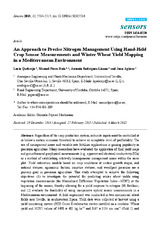An Approach to Precise Nitrogen Management Using Hand-Held Crop Sensor Measurements and Winter Wheat Yield Mapping in a Mediterranean Environment
Autor
Quebrajo, Lucía
Pérez Ruiz, Manuel
Rodríguez Lizana, Antonio
Agüera Vega, Juan
Editor
MDPIFecha
2015Materia
NDVIYield estimation
Winter wheat
METS:
Mostrar el registro METSPREMIS:
Mostrar el registro PREMISMetadatos
Mostrar el registro completo del ítemResumen
Regardless of the crop production system, nutrients inputs must be controlled at
or below a certain economic threshold to achieve an acceptable level of profitability. The
use of management zones and variable-rate fertilizer applications is gaining popularity in
precision agriculture. Many researchers have evaluated the application of final yield maps
and geo-referenced geophysical measurements (e.g., apparent soil electrical conductivity-ECa)
as a method of establishing relatively homogeneous management zones within the same
plot. Yield estimation models based on crop conditions at certain growth stages, soil
nutrient statuses, agronomic factors, moisture statuses, and weed/pest pressures are a
primary goal in precision agriculture. This study attempted to achieve the following
objectives: (1) to investigate the potential for predicting winter wheat yields using
vegetation measurements (the Normalized Difference Vegetation Index—NDVI) at the
beginning of the season, thereby allowing for a yield response to nitrogen (N) fertilizer;
and (2) evaluate the feasibility of using inexpensive optical sensor measurements in a
Mediterranean environment. A field experiment was conducted in two commercial wheat
fields near Seville, in southwestern Spain. Yield data were collected at harvest using a
yield monitoring system (RDS Ceres II-volumetric meter) installed on a combine. Wheat
yield and NDVI values of 3498 ± 481 kg ha−1 and 0.67 ± 0.04 nm nm−1 (field 1) and 3221 ± 531 kg ha−1 and 0.68 ± 0.05 nm nm−1 (field 2) were obtained. In both fields, the
yield and NDVI exhibited a strong Pearson correlation, with rxy = 0.64 and p < 10−4 in field
1 and rxy = 0.78 and p < 10−4 in field 2. The preliminary results indicate that hand-held crop
sensor-based N management can be applied to wheat production in Spain and has the
potential to increase agronomic N-use efficiency on a long-term basis.

